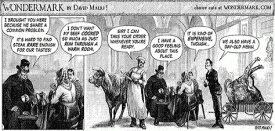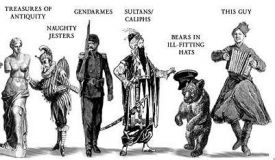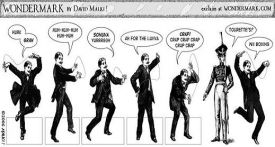- Comics
- Comics Reviews
- Manga
- Comics Reviews
- European Comics
- News
- Comics News
- Press Releases
- Columns
- Spotlight
- Digital Comics
- Webcomics
- Cult Favorite
- Back Issues
- Webcomics
- Movies
- Toys
- Store
- More
- About
By Geoff Hoppe
July 20, 2008 - 20:47
It’s weird, it’s brilliant, it’s Wondermark, David Malki’s twisted dispatch from the heart of the 1800s. In Wondermark, a webcomic updated twice weekly, David Malki takes images from nineteenth-century artwork and uses them as characters in a variety of situations. His pythonesque use of collage makes for a delightfully bizarre, often sardonic, and sometimes enjoyably destructive experience. From Biblical Mad Libs to demented Boxing Day rituals, Wondermark tends to skewer anything and everything that comes to the artist’s mind.
I took the time to pick Mr. Malki’s brain and see if I get behind the dementia.
Q. How did you get started? What was your motivation in creating Wondermark?
A. I get this question a lot, and I've never been able to come up with a satisfactory answer. There was no epiphany moment when I had some bolt of insight. By the time I decided to do it I had already made ten or twenty strips. I was working an unsupervised night shift at the time so I believe I was even paid to do so.

Q. What are your influences? Both in comics, and in comedy in general?
A. I'm in so much awe of Charles Schulz it's ridiculous. He invented the funny talking-heads comic strip and imbued his characters with such personality and pathos over the years -- there's a reason they're so indelible in the culture. It's a bit weird to see them on greeting cards wishing everyone a happy day when their days were so filled with misery, but whatever.
His strip is also so very, very deadpan, which I love. I'm not a big fan of winking at the audience. For that reason I also enjoy things like John Hodgman's book The Areas of my Expertise. It takes total absurdity and presents it with an absolutely straight face. If there's any overarching goal I've ever had with the strip, it's that.
Also, I just re-read Amphigorey by Edvard Gorey. I love the whimsical darkness of his work, and the precise weirdness of his pen. I did a limited-print calendar last year with some verse that was heavily inspired by him.
And I'm also very inspired by the successful webcartoonists I've met and have developed friendships with. They make me elevate my game, and show me what's possible.
Q. Though you have a book collection (published by Dark Horse) due out this July 2nd, you started off, and still publish twice weekly, in a web comic format. Was Wondermark originally designed to be a webcomic?
A. Wondermark started as a webcomic before I knew what webcomics were. I was just trying to make a comic strip and put it on a website and sort of made a webcomic by accident. Once I found out what I'd done I was totally mortified but it was rather too late to turn back.

Unfortunately in my opinion, webcomics have become sort of infected with a comic-booky personality. There are a lot of nerdy comic-book ways of talking about webcomics, when in my opinion webcomics should be talked about like websites. Way more people visit websites than read comic books. And while I'm very thrilled to present the strip in a beautiful way, and also hopefully broaden its audience, with the new Dark Horse book, I don't think that print is the be-all and end-all of comics anymore. With any entertainment product, you're best off going where the people are. The top 10 best-selling comic books these days are moving 95,000–184,000 copies. That's the audience of a mid-tier webcomic, with the top webcomics comfortably in the millions.
There's a conversation here, as well, about the difference in audience appeal between comic books and comic strips, but it's a rant I've done recently for Tom Spurgeon so I'll spare it now.
Q. Does the fact that Wondermark is an electronic medium make you approach the creative process any differently than you would in print?
A. I'm not sure what it would be different from, since the strip's always been on the Web. Being on the Web allows the audience to interact with the strip and me and each other in cool and interesting ways, which I think is a big advantage and why, I think, anyone would want to do a webcomic. I think it must be a different process than working strictly for print, because so many print cartoonists are terrified of the Web.
When you set up your own website and act as your own editor and creative team and publisher and merchandise designer and shopkeeper and customer-service agent, whether it works or doesn't rests squarely on your shoulders.
It doesn't always work, and those days are tough. But it's nice, too -- because when it does occasionally work, you know it's because of something you, yourself, did.
Q. The worlds of both comic strips and comic books are vibrant communities where people often know each other. Do you find the web comic community to be the same way? Is there a lot of creative cross pollination?
A. I've made a conscious effort to meet other comic creators and creative people, and I've found it to be a universally positive experience. The creative cross pollination is there to a degree, though everyone's usually pretty focused on their own product so there aren't always a lot of opportunities for collaboration. But there aren't a ton of people in the world making a living from webcomics, so it's nice to simply sit and chat and swap tips. I don't know who said this first, but it's true: "When businessmen get together they talk art. When artists get together they talk business."

Everything I know about making a living at comics has grown from basic, foundational things I've learned either directly or indirectly from other artists. How to tap into communities, how to treat your fans, how to treat the work itself.
It's also just nice to have some friends who understand the process. I have dear friends that I went to college with whom I can't really talk webcomics with, because they're not interested or don't know what I'm talking about. I don't think I'd have gotten this far if I hadn't found people I could just have no-holds-barred conversations about the craft with.
Q. Right down to the titles of your comics, which all incorporate the words "in which," you've got Victorian vocabulary down to a science. Were you a history major in college?
A. No, I was an illustration major for a while, then went on to get a degree in film production. I never liked history until I started learning about it on my own, on my own pace, concentrating on the parts that fascinated me. I think that's the case with a lot of subjects for a lot of people.
But I've always had a very keen ear for mimicking styles. In English class, when we were given the choice to write a straight essay or some alternate thing -- a Socratic dialogue, a pastiche of one of the books we were studying, etc. -- I always chose the alternate thing. I pick up on the rhythms of a style and can parody styles of writing pretty easily. Maybe it's because I tend to notice how writing is put together -- how punctuation is employed, why certain words are used versus synonyms.
I should have probably asked for a better talent from that genie.
Q. Where do you get all the pictures you use?
A. Most of them come from my collection of 19th-century books, of which most of those are periodicals. I've also got some dry-goods catalogs, story collections, and other miscellaneous acquisitions. Basically anything from the late Victorian era that catches my eye as something full of the type of engravings that I like to use, I try topick up for the collection. Sometimes I also visit the library with a scanner and access their archival periodical collection.
I usually do that when I'm looking for something really specific -- for example recently I scanned a bunch of mechanical gizmos from old Scientific Americans.
In the rare cases when I can't find or build something really specific that I need, I dust off the old time-traveling telegraph and send a request to 1887. Unfortunately I have yet to hear anything back besides "WHAT IS AN IPOD STOP"
Q. Do you ever worry about Trader Joe's cramping your style? They have similar cartoons with nineteenth-century illustrations in their circulars.
A. I only learned about that when I showed some Wondermark strips to a colleague of mine at an advertising agency where I worked. He mumbled something about "oh, you're ripping off Trader Joe's" and I had no idea what he meant. Later I started receiving the Fearless Flyer in the mail and got wind of the situation. Unfortunately all the lawyers that represent this type of artwork all went out of business in 1895 so I haven't had much luck pursuing the matter.
But really, until I go senile and start making my comics all about whatever type of cheese is on sale that week, I think Trader Joe's and I are probably working in pretty separate spheres.
Q. A lot of these strips have the same manic, random humor that made Pinky and the Brain or (pre-cancellation) Family Guy hilarious—where do your ideas come from? Can you give us any idea of how the randomness works?
A. A lot of it comes from whatever's going on in the images that I find, or the situation suggested by putting two unrelated images together. Maybe it's my training as a film editor, but I've always had a keen eye for finding juxtapositions that are rich with possibility. The more random strips are usually the result of just putting weird things together and then trying to figure out what in the world is going on. And a not-insignificant percentage of the strips are just verbatim conversations between me and my wife.
Occasionally, when my workload gets heavy, I'll call on Strip Creation Team Bravo in
Q. Back to your upcoming book collection. How did you get hooked up with Dark Horse? Anything we should know about the new book?
A. Not many people know that behind the Dark Horse publishing empire there actually is a literal dark horse. He is a swarthy stallion named Morton. We actually knew each other a bit in college, but I wasn't much of a partier so we didn't talk much. Anyway, we ran into each other randomly in the security line at the
The book itself is pretty straightforward. Unlike my previous, self-published collection, The Annotated Wondermark, the new book is read in a traditional manner by lifting the cover and moving your eye around the left page, then the right, then turning the page and repeating. If you're used to this rather common way of reading then you shouldn't have any trouble with the book.
I should also mention that I'm a big fan of taking advantage of the benefits of different types of media. I think the book does a lot of things really well that only books can do. I've tried really hard to make it something much more than just a printout of the website.
Q. Of the 400+ strips you've created, do you have a personal favorite?
A. I'm particularly fond of episode #260, for several reasons. The punchline requires a logical leap for the reader, and involves them in that way.
The setting evokes a pretty interesting scenario without having to supply many details.
And I'm proud of the craft that went into creating it -- it's an important milestone strip for me in terms of experimenting with new levels of complexity.
Um I mean I should say "I love all my children equally, of course"
Q. Last but not least, why does Heathcliff need a bookie? His comic strip and cartoon show sucked goat eggs.
A. Heathcliff needs a bookie because he has a crippling gambling addiction.